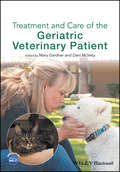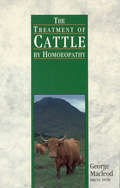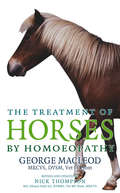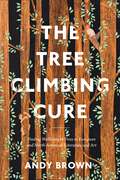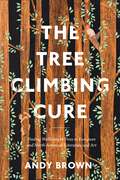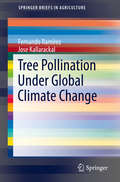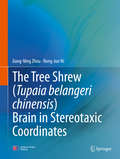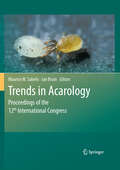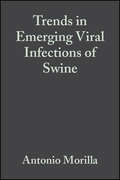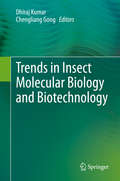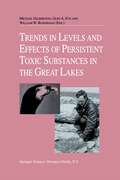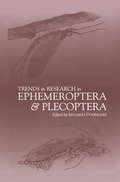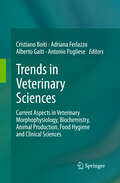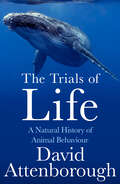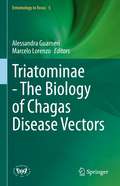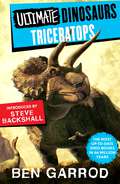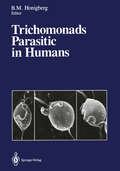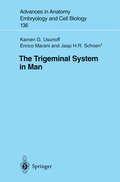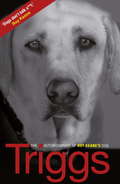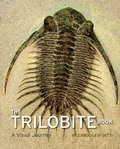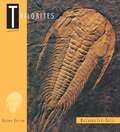- Table View
- List View
Treatment and Care of the Geriatric Veterinary Patient
by Mary Gardner Dani McVetyTreatment and Care of the Geriatric Veterinary Patient offers veterinarians a complete guide to treating and managing geriatric canine and feline patients. Offers practical guidance on managing all aspects of veterinary care in geriatric pets Takes a holistic approach to managing the geriatric patient, from common diseases and quality of life to hospice, euthanasia, client communications, and business management Focuses on dogs and cats, with a chapter covering common exotic animals Provides clinically oriented advice for ensuring quality of life for older pets Includes access to a companion website with videos, client education handouts, and images
The Treatment Of Cattle By Homoeopathy
by George MacleodMany farmers today are concerned, not only with the increasing cost of conventional drugs, but also with their side-effects and the build-up of resistant strains of bacteria due to the continued and often indiscriminate use of antibiotics.While this book will appeal to the already converted it is hoped that the unprejudiced newcomer will be sufficiently encouraged to investigate this system of medicine and enjoy its undoubted benefits.The aim of the homeopathic approach is to build up the health of the herd and increase the resistance of its individual members to disease, and, in consequence to increase the milk output and quality.Homeopathic remedies are all derived from natural sources and George Macleod outlines the homeopathic approach to the commoner diseases of cattle, omitting only serious injuries and others which are not economic to treat.
The Treatment Of Horses By Homoeopathy
by George MacleodThis book is for anyone who is interested in the welfare of horses, and who wishes to know more about treating them with homoeopathic remedies. Increasing numbers of horse owners and handlers today confirm that homoeopathy is a speedy and effective treatment, which can often deal with so-called 'incurable' ailments. As this fascinating guide explains, homoeopathic remedies are absolutely safe, easy to administer and have no side effects. This authoritative book includes advice on treating horses homoeopathically for both specific diseases and common ailments.
The Tree Climbing Cure: Finding Wellbeing in Trees in European and North American Literature and Art (Environmental Cultures)
by Andy BrownOur relationship with trees is a lengthy, complex one. Since we first walked the earth we have, at various times, worshiped them, felled them and even talked to them. For many of us, though, our first memories of interacting with trees will be of climbing them.Exploring how tree climbers have been represented in literature and art in Europe and North America over the ages, The Tree Climbing Cure unpacks the curative value of tree climbing, examining when and why tree climbers climb, and what tree climbing can do for (and say about) the climber's mental health and wellbeing.Bringing together research into poetry, novels, and paintings with the science of wellbeing and mental health and engaging with myth, folklore, psychology and storytelling, Tree Climber also examines the close relationship between tree climbing and imagination, and questions some longstanding, problematic gendered injunctions about women climbing trees. Discussing, among others, the literary works of Margaret Atwood; Charlotte Bronte; Geoffrey Chaucer; Angela Carter; Kiran Desai; and J.R.R. Tolkien, as well as work by artists such as Peter Doig; Paula Rego; and Goya, this book stands out as an almost encyclopedic examination of cultural representations of this quirky and ultimately restorative pastime.
The Tree Climbing Cure: Finding Wellbeing in Trees in European and North American Literature and Art (Environmental Cultures)
by Andy BrownOur relationship with trees is a lengthy, complex one. Since we first walked the earth we have, at various times, worshiped them, felled them and even talked to them. For many of us, though, our first memories of interacting with trees will be of climbing them.Exploring how tree climbers have been represented in literature and art in Europe and North America over the ages, The Tree Climbing Cure unpacks the curative value of tree climbing, examining when and why tree climbers climb, and what tree climbing can do for (and say about) the climber's mental health and wellbeing.Bringing together research into poetry, novels, and paintings with the science of wellbeing and mental health and engaging with myth, folklore, psychology and storytelling, Tree Climber also examines the close relationship between tree climbing and imagination, and questions some longstanding, problematic gendered injunctions about women climbing trees. Discussing, among others, the literary works of Margaret Atwood; Charlotte Bronte; Geoffrey Chaucer; Angela Carter; Kiran Desai; and J.R.R. Tolkien, as well as work by artists such as Peter Doig; Paula Rego; and Goya, this book stands out as an almost encyclopedic examination of cultural representations of this quirky and ultimately restorative pastime.
Tree of Origin: What Primate Behavior Can Tell Us about Human Social Evolution
by F. B. WaalHow did we become the linguistic, cultured, and hugely successful apes that we are? Our closest relatives--the other mentally complex and socially skilled primates--offer tantalizing clues. In Tree of Origin nine of the world's top primate experts read these clues and compose the most extensive picture to date of what the behavior of monkeys and apes can tell us about our own evolution as a species. It has been nearly fifteen years since a single volume addressed the issue of human evolution from a primate perspective, and in that time we have witnessed explosive growth in research on the subject. Tree of Origin gives us the latest news about bonobos, the "make love not war" apes who behave so dramatically unlike chimpanzees. We learn about the tool traditions and social customs that set each ape community apart. We see how DNA analysis is revolutionizing our understanding of paternity, intergroup migration, and reproductive success. And we confront intriguing discoveries about primate hunting behavior, politics, cognition, diet, and the evolution of language and intelligence that challenge claims of human uniqueness in new and subtle ways. Tree of Origin provides the clearest glimpse yet of the apelike ancestor who left the forest and began the long journey toward modern humanity.
Tree Pollination Under Global Climate Change (SpringerBriefs in Agriculture)
by Fernando Ramírez Jose KallarackalThis brief reviews the pollination aspects of both wild and domesticated fruit tree species in a global climate change context. It explores cross-pollination mediated by insects, vertebrates and abiotic factors, self-pollination and their global warming implications. The authors identify the link between abiotic factors such as precipitation and severe droughts in the context of tree pollination and climate change. Furthermore, pollination and conservation implications in agriculture as well as wild tree populations are explored. Emphasis has been given to fruit trees growing in tropical, subtropical and temperate environments.
The Tree Shrew (Tupaia belangeri chinensis) Brain in Stereotaxic Coordinates
by Jiang-Ning Zhou Rong-Jun NiThis atlas is currently the most systematic and comprehensive atlas of the tree shrew brain. The purpose of this book is to help scientists acquire accurate coordinates of the brain regions of the tree shrew, which is becoming a popular animal model for a variety of human diseases. This atlas contains series of 192 coronal sections, 36 sagittal sections, and 49 horizontal sections using Nissl staining or acetylcholinesterase histochemistry as well as a series of diagrams in stereotaxic coordinates. Original photomicrographs are obtained at single-cell resolution. In addition, we also referred to magnetic resonance images acquired at 250 um intervals with a magnetic resonance scanner 9.4T. Many brain structures are first identified in tree shrews and accurately presented in a stereotaxic coordinate system. The Bregma coordinates system is used for the first time in this tree shrew brain atlas. The atlas represents the collaboration between two indispensable skills of brain research, neuroanatomy and stereotaxic surgery. It will be extensively used in neuroscience research, particularly tree shrew brain study, and will help graduate students and researchers understand brain anatomy and acquire accurate reference coordinates.
Trends in Acarology: Proceedings of the 12th International Congress
by Maurice W. Sabelis Jan BruinMites and ticks are everywhere and acarologists go after them – some explore their bewildering diversity, others try to understand their how and why. For the past 50 years, the International Congress of Acarology has been the forum for worldwide communication on the knowledge of Acari, helping researchers and students to look beyond their disciplines. Many mites and ticks are economic factors as they are pests of agricultural, veterinary and medical importance, and several species have become model organisms in modern biology. The 96 contributions to Trends in Acarology – reflecting fields as molecular biology, biochemistry, physiology, microbiology, pathology, ecology, evolutionary biology, systematic biology, soil biology, plant protection, pest control and epidemiology – have been reviewed and carefully edited. This volume contains a wealth of new information, that may stimulate research for many years to come.
Trends in Emerging Viral Infections of Swine
by Antonio Morilla Kyoung-Jin Yoon Jeffrey J. ZimmermanTrends in Emerging Viral Infections of Swine includes sections on global trade, vaccination regimens against new and emerging viruses, epidemiology and control, as well as significant new outbreaks like the West Nile virus. A contributor to Diseases of Swine, 8th edition, Dr. Zimmerman has selected three additional editors with international expertise.
Trends in Insect Molecular Biology and Biotechnology
by Dhiraj Kumar Chengliang GongThis book provides an overview on the basics in insect molecular biology and presents the most recent developments in several fields such as insect genomics and proteomics, insect pathology and applications of insect derived compounds in modern research. The book aims to provide a common platform for the molecular entomologist to stimulate further research in insect molecular biology and biotechnology.Insects are one of the most versatile groups of the animal kingdom. Due to their large population sizes and adaptability since long they attract researchers’ interest as efficient resource for agricultural and biotechnological purposes. Several economically important insects such as Silkworms, Honey Bee, Lac and Drosophila or Termites were established as invertebrate model organisms. Starting with the era of genetic engineering, a broad range of molecular and genetic tools have been developed to study the molecular biology of these insects in detail and thus opened up a new horizon for multidisciplinary research. Nowadays, insect derived products are widely used in biomedical and biotechnology industries. The book targets researchers from both academia and industry, professors and graduate students working in molecular biology, biotechnology and entomology.
Trends in Levels and Effects of Persistent Toxic Substances in the Great Lakes: Articles from the Workshop on Environmental Results, hosted in Windsor, Ontario, by the Great Lakes Science Advisory Board of the International Joint Commission, September 12 and 13, 1996
by William W. Bowerman Glen A. Fox MichaelGilbertson`Are the Great Lakes getting better or worse?' This is the question that the public, scientists and managers are asking the International Joint Commission after a quarter-century of cooperative action by the United States and Canadian governments to clean up the Great Lakes. This volume contains papers from the workshop on Environmental Results, hosted in Windsor, Ontario, by the Great Lakes Science Advisory Board of the International Joint Commission, on September 12 and 13, 1996. The Great Lakes have been through almost a century of severe pollution from the manufacture, use and disposal of chemicals. In the 1960s wildlife biologists started to investigate the outbreaks of reproductive failure in fish-eating birds and ranch mink and to link these to exposure to organochlorine compounds. Human health researchers in the 1980s and 1990s linked growth retardation, behavioral anomalies and deficits in cognitive development with maternal consumption of Great Lakes fish prior to pregnancy. The Great Lakes became the laboratory where the theory of endocrine disruptors was first formulated. Now a group of Great Lakes scientists, hosted by the International Joint Commission, has compiled the story of the trends in the concentrations and effects of persistent toxic substances on wildlife and humans. The technical papers review the suitability of various organisms as indicators, and present the results of long-term monitoring of the concentrations and of the incidence of effects. The evidence shows that there was an enormous improvement in the late 1970s, but that in the late 1990s there are still concentrations of some persistent toxic substances that have stubbornly remained at levels that continue to cause toxicological effects.
Trends in Veterinary Sciences: Current Aspects in Veterinary Morphophysiology, Biochemistry, Animal Production, Food Hygiene and Clinical Sciences
by Cristiano Boiti, Adriana Ferlazzo, Alberto Gaiti and Antonio PuglieseVeterinary science is continuously achieving important developments in all its fields as a result of continuous technological advances in diagnostic tools and applied biology. This book contains 33 papers that were selected from those presented at the 65th Congress of the Italian Society for Veterinary Sciences held at Tropea-Drapia in 2011. It provides a timely overview of the current progress being made by Italian researchers and is of great value to anyone interested in all fields of veterinary science, both theoretical and applied, ranging from animal health and care to animal production and food hygiene.
The Trials of Life: A Natural History Of Animal Behaviour
by David AttenboroughThe third and final updated edition of David Attenborough’s classic Life trilogy. Life on Earth covered evolution, Living Planet , ecology, and now The Trials of Life tackles ethology, the study of how animals behave.
Triatominae - The Biology of Chagas Disease Vectors (Entomology in Focus #5)
by Alessandra Guarneri Marcelo LorenzoThis book aims to present updated knowledge on various aspects of the natural history, biology, and impact of triatomines to all interested readers. Each chapter will be written by authorities in the respective field, covering topics such as behavior, neurophysiology, immunology, ecology, and evolution. The contents will consider scientific, as well as innovative perspectives, on the problems related to the role of triatomine bugs as parasite vectors affecting millions in the Latin American region.
Triceratops (Ultimate Dinosaurs #3)
by Ben GarrodDid Triceratops have huge, inflatable nose balloons? Was it smaller or larger than an elephant? And did it have a beak or teeth or BOTH? Quench your thirst for dino knowledge with the Ultimate Dinosaur series!Pop a dinosaur in your pocket! Introductions from Chris Packham, Steve Backshall and Dr Jane Goodall. These are the most up-to-date dino books in 66 million years, also available in audio download!TV scientist, Professor Ben Garrod, is proud to be a geek as he mixes top level science and humour to prove that science is for everyone. Looking at the evolutionary arms race, prey, predators, place, time, groups and species, Ben reveals new-look dinosaurs. Additional sections include: Ask an Expert, New Science and Fossil Finder as well as quizzes to test your dinosaur knowledge.
The Trigeminal System in Man (Advances in Anatomy, Embryology and Cell Biology #136)
by Kamen G. Usunoff Enrico Marani Jaap H.R. SchoenThis monograph offers a comprehensive review of present knowledge of the structure and connections of the trigeminal nuclei in humans, and compares it to laboratory animal findings. The authors provide cytoarchitectural data from their own research, and trace trigeminal pathways in human material by means of the Nauta technique. In humans the trigeminal nuclear complex includes the motor nucleus, the principal sensory (pontine) nucleus, the spinal nucleus (subdivided into oral, interpolar and caudal nuclei), and the mesencephalic nucleus and several small nuclei. The supratrigeminal nucleus, as described in various mammals, is not defined in the human brain. The primary afferents to all subdivisions of the trigeminal nuclear complex in humans appear to be entirely ipsilateral. Some of the 'extratrigeminal' primary afferents described in experimental animals are also present in the human brain and the nucleus ovalis receives primary and possibly secondary afferents from the trigeminal systems. A significant difference between the human trigeminal system and the subprimate species is seen in the monosynaptic cortical projection to the motor trigeminal nucleus.
Triggs: The Autobiography of Roy Keane's Dog
by TriggsThe explosive, no-holds-barred autobiography of Triggs, Roy Keane's confidant, adviser...and dog!Ten major trophies. A missed Champions League final. Player of the Year awards. Alf-Inge Haaland. Drunken nights. Contract negotiations. Patrick Vieira. Prawn sandwiches. The explosive end to Roy's relationship with Ireland and Manchester United. Triggs - TV lover, hypochondriac, noted wit, football genius and best friend to the most talked-about footballer of his generation - was witness to it all. Funny, frank and never less than 110 per cent mean-spirited, Triggs tells the truth about what it was like to be a central player in the extraordinary drama of her master's life.
The Trilobite Book: A Visual Journey
by Riccardo Levi-SettiDistant relatives of modern lobsters, horseshoe crabs, and spiders, trilobites swam the planet’s prehistoric seas for 300 million years, from the Lower Cambrian to the end of the Permian eras—and they did so very capably. Trilobite fossils have been unearthed on every continent, with more than 20,000 species identified by science. One of the most arresting animals of our pre-dinosaur world, trilobites are also favorites among the fossil collectors of today, their crystalline eyes often the catalyst for a lifetime of paleontological devotion. And there is no collector more devoted—or more venerated—than Riccardo Levi-Setti. With The Trilobite Book, a much anticipated follow-up to his classic Trilobites, Levi-Setti brings us a glorious and revealing guide to these surreal arthropods of ancient Earth. Featuring specimens from Bohemia to Newfoundland, California to the Tucson Gem and Mineral Show, and Wales to the Anti-Atlas Mountains of Morocco, Levi-Setti’s magnificent book reanimates these “butterflies of the seas” in 235 astonishing full-color photographs. All original, Levi-Setti’s images serve as the jumping-off point for tales of his global quests in search of these highly sought-after fossils; for discussions of their mineralogical origins, as revealed by their color; and for unraveling the role of the now-extinct trilobites in our planetary history. Sure to enthrall paleontologists with its scientific insights and amateur enthusiasts with its beautiful and informative images, The Trilobite Book combines the best of science, technology, aesthetics, and personal adventure. It will inspire new collectors for eras to come.
The Trilobite Book: A Visual Journey
by Riccardo Levi-SettiDistant relatives of modern lobsters, horseshoe crabs, and spiders, trilobites swam the planet’s prehistoric seas for 300 million years, from the Lower Cambrian to the end of the Permian eras—and they did so very capably. Trilobite fossils have been unearthed on every continent, with more than 20,000 species identified by science. One of the most arresting animals of our pre-dinosaur world, trilobites are also favorites among the fossil collectors of today, their crystalline eyes often the catalyst for a lifetime of paleontological devotion. And there is no collector more devoted—or more venerated—than Riccardo Levi-Setti. With The Trilobite Book, a much anticipated follow-up to his classic Trilobites, Levi-Setti brings us a glorious and revealing guide to these surreal arthropods of ancient Earth. Featuring specimens from Bohemia to Newfoundland, California to the Tucson Gem and Mineral Show, and Wales to the Anti-Atlas Mountains of Morocco, Levi-Setti’s magnificent book reanimates these “butterflies of the seas” in 235 astonishing full-color photographs. All original, Levi-Setti’s images serve as the jumping-off point for tales of his global quests in search of these highly sought-after fossils; for discussions of their mineralogical origins, as revealed by their color; and for unraveling the role of the now-extinct trilobites in our planetary history. Sure to enthrall paleontologists with its scientific insights and amateur enthusiasts with its beautiful and informative images, The Trilobite Book combines the best of science, technology, aesthetics, and personal adventure. It will inspire new collectors for eras to come.
The Trilobite Book: A Visual Journey
by Riccardo Levi-SettiDistant relatives of modern lobsters, horseshoe crabs, and spiders, trilobites swam the planet’s prehistoric seas for 300 million years, from the Lower Cambrian to the end of the Permian eras—and they did so very capably. Trilobite fossils have been unearthed on every continent, with more than 20,000 species identified by science. One of the most arresting animals of our pre-dinosaur world, trilobites are also favorites among the fossil collectors of today, their crystalline eyes often the catalyst for a lifetime of paleontological devotion. And there is no collector more devoted—or more venerated—than Riccardo Levi-Setti. With The Trilobite Book, a much anticipated follow-up to his classic Trilobites, Levi-Setti brings us a glorious and revealing guide to these surreal arthropods of ancient Earth. Featuring specimens from Bohemia to Newfoundland, California to the Tucson Gem and Mineral Show, and Wales to the Anti-Atlas Mountains of Morocco, Levi-Setti’s magnificent book reanimates these “butterflies of the seas” in 235 astonishing full-color photographs. All original, Levi-Setti’s images serve as the jumping-off point for tales of his global quests in search of these highly sought-after fossils; for discussions of their mineralogical origins, as revealed by their color; and for unraveling the role of the now-extinct trilobites in our planetary history. Sure to enthrall paleontologists with its scientific insights and amateur enthusiasts with its beautiful and informative images, The Trilobite Book combines the best of science, technology, aesthetics, and personal adventure. It will inspire new collectors for eras to come.
The Trilobite Book: A Visual Journey
by Riccardo Levi-SettiDistant relatives of modern lobsters, horseshoe crabs, and spiders, trilobites swam the planet’s prehistoric seas for 300 million years, from the Lower Cambrian to the end of the Permian eras—and they did so very capably. Trilobite fossils have been unearthed on every continent, with more than 20,000 species identified by science. One of the most arresting animals of our pre-dinosaur world, trilobites are also favorites among the fossil collectors of today, their crystalline eyes often the catalyst for a lifetime of paleontological devotion. And there is no collector more devoted—or more venerated—than Riccardo Levi-Setti. With The Trilobite Book, a much anticipated follow-up to his classic Trilobites, Levi-Setti brings us a glorious and revealing guide to these surreal arthropods of ancient Earth. Featuring specimens from Bohemia to Newfoundland, California to the Tucson Gem and Mineral Show, and Wales to the Anti-Atlas Mountains of Morocco, Levi-Setti’s magnificent book reanimates these “butterflies of the seas” in 235 astonishing full-color photographs. All original, Levi-Setti’s images serve as the jumping-off point for tales of his global quests in search of these highly sought-after fossils; for discussions of their mineralogical origins, as revealed by their color; and for unraveling the role of the now-extinct trilobites in our planetary history. Sure to enthrall paleontologists with its scientific insights and amateur enthusiasts with its beautiful and informative images, The Trilobite Book combines the best of science, technology, aesthetics, and personal adventure. It will inspire new collectors for eras to come.
Trilobites: A Visual Journey
by Riccardo Levi-SettiLong before dinosaurs roamed the earth, there were trilobites—one of the most striking animals to populate prehistoric seas and whose fossils are favorites among collectors today. From the giant trilobites of Newfoundland to fascinating new specimens from Morocco, Levi-Setti's magnificent book brings these "butterflies of the sea" to life for everyone curious about our remote past This second edition features coverage of a greater variety of trilobites, an improved photographic atlas reorganized to present their evolutionary progression, and over 200 photographs.
